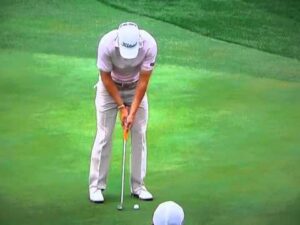Why not increase your odds of sinking more putts? Almost half of your strokes in a round of golf are putts. Fewer putts per green is the easiest way to lower your score. Stop your shaking hands & wrists, avoid mishits on the toe or heel and eliminate short putts (100% of them never go in).
The solution is simple: Fix your line-up, setup, swing motion on your target line, impact and putting distance to increase your odds for success. All of this is wasted if you don’t get a FEEL for the speed of the greens that you are playing on before each round of golf.
Reading the break and distance to hit the putt can only be learned by YOUR “FEEL” for the green speed. You need to learn this on the practice green before you play. Dry or wet conditions, height of the grass and roll of the grass will all have a major impact on your “feel” for the speed of putts on each day on each course.
Now let’s consider each area of putting that you CAN control.

Jordan Spieth using shoulder rock and straight leading wrist for putting excellence to win the US Open.
Line-up: Stand BELOW the hole or your ball to determine if you are putting up, down or across a slope. Determine the intensity of the break by ranking the slope as “1”, “2” or “3” (minimal to major break). It’s easier to see the slope of the green LOOKING UP HILL. Choose a target point on the green to aim your putt (DEPENDING ON THE INTENSITY OF THE BREAK) and line your toes up parallel to that line for your practice swings. Make sure that you make a few practice swings to get the feel for the swing that you expect will get your ball 10 to 18 inches past the hole. That is aggressive putting. According to the US Open commentators, aggressive putting won it for Jordon Spieth.
Setup: Ensure that the ball is just in front of the center-line between your feet. Hit the ball on the upswing of the arc of your swing to ensure that is rolling and not bouncing at the point of Impact.
Swing Motion: Swing with your shoulders and spine to avoid any shaking motion in your small hand and wrist muscles. Practice with GOLFSTR+ to learn to lock your wrist flat with your forearm. Use the rocking motion of your shoulders and spine to create your swing. The large muscles in your back will give you a smooth takeaway and swing.
Follow-through: Your body acts like a pole so your spine and shoulder rotation will cause your putter to arc around the “pole” (possibly causing the ball to spay right or left depending on your point of contact in the arc). To hit the ball straight up your target line, finish your swing by swaying your hips and putter slightly up the target line. [Try finishing the swing by releasing the putter with your trailing hand and letting your leading hand swing up the target line or just end your swing by pointing up the target line.]
Impact: Focus your eyes on the grass before the ball to ensure that you hit it on the center-line of the putter head. Swing directly up the target line to avoid any side spin off the head of the putter
Distance: Hit past the hole by 10 to 18 inches to minimize the impact of the contour break or surface bumps as the ball slows down. If you rate the slope as a minimal break of “1”, you should account for minimal break when you plan to hit through the break at the hole. Dustin Johnson would have tied the US Open if he had hit his last short putt straight at the hole and through the break.
GOLFSTR+ is great for putting practice and 5 other swing solutions. Buy it today on our website: www.golfstr.com


